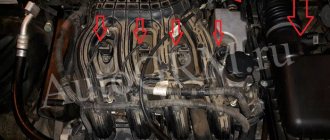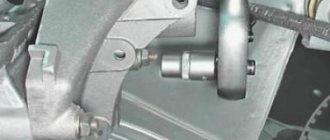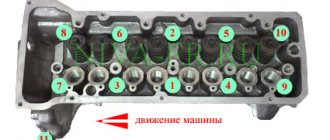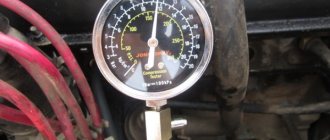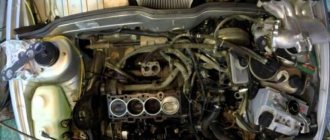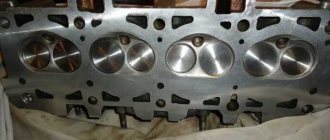After carrying out repair work on the car's chassis, many beginners feel that the most difficult part of the work is left behind. But in order to fasten the wheel, some, without calculating their own strength, break a bolt or stud. This problem is relevant among many drivers. To avoid adverse consequences, you need to purchase a torque wrench and master the skills.
What you need to properly tighten your wheel bolts
Many people often wonder how hard they can tighten wheel nuts at home. This process seems quite simple at first glance. Before starting a step-by-step action, a person must prepare certain tools. Very often, car owners independently perform these actions at home and, without counting their strength, break the thread. This is due to the beginner putting enough pressure on the bolts.
Bolt tightening process
The tightening torque of the wheel bolts is carried out with the preparation of the necessary tools. To perform the process correctly, you need to purchase a special torque wrench. Without this tool it is difficult to imagine the process of tightening bolts.
If this development is not available, you can use a pneumatic impact wrench. Many stations provide professional maintenance with this product.
As a rule, a pneumatic impact wrench regulates the tightening torque of elements on a structure. If a bolt that is not tightened protrudes from the front, then discomfort will be felt while moving on the vehicle. That is, the car will “shake” a little. After all, the main load falls on the steering wheel.
If the wheel is loosely tightened on the rear of the axle, then the tires will wear out quickly. There is also the possibility of damage to the steering rod and destruction of the bearings.
Marking and strength class of parts
The numerical designation of the strength parameter of a metric bolt is indicated on the head, and is presented in the form of two numbers separated by a dot, for example: 4.6, 5.8 and so on.
Designation of the strength class of metric bolts
The yield strength represents the maximum load on the bolt structure. Elements that are made from stainless steel types are designated directly by the type of steel itself (A2, A4), and only after that the ultimate strength is indicated.
For example, A2-50. The value in such markings indicates 1/10 of the strength limit of carbon steel. At the same time, products for the manufacture of which carbon steel is used have a strength class of 2.
The strength designation for inch bolts is marked with notches on its head.
Designation of the strength class of inch bolts
How the tool works
Semi-automatic torque wrenches resemble in shape and design a regular ratchet wrench, which is used for socket heads. The only significant difference from its “brothers” is the presence of a special ratcheting mechanism, which allows the built-in gear to rotate in two directions.
For example, to return the handle of a tool back after a full rotation, you need to apply relatively little force. But to tighten the nut you need to apply a little more force.
When the required value is reached, the ratchet gear simply begins to slip (a characteristic sound is heard), as a result of which the nut or bolt is no longer tightened. This eliminates the possibility that the thread will break.
Torque wrenches with a force measurement scale by default do not have the ability to limit torque when a specified value is reached. In this case, this moment must be controlled independently using a mechanical or electronic digital measuring scale.
A homemade almost torque wrench, depending on the design, can work according to the example of the first and second options described above.
Why do we count Newtons and meters?
Before you start making a simple homemade torque wrench for tightening bolts and nuts, you will need to do some calculations. For example, to achieve a tightening torque of 10 N*m, you need to apply a force equal to one kilogram of force to a lever or arm 1 meter long.
But in a home workshop or garage, a meter lever is not the most practical and convenient option. Ideally, it is better to use a lever within 20–50 cm. And in order to correctly calculate how much force needs to be applied to the lever to achieve the required tightening torque, you need to count Newtons and meters.
However, it is not at all necessary to go into the jungle of mathematical equations. The required values can be easily calculated in proportion. That is, if we take as a basis that to obtain a torque of 10 N*m, you need to apply a force of 1 kg on a meter-long lever, then it is similarly easy to calculate how much force will need to be applied to a lever of shorter length.
The shorter the lever used, the greater the force required to tighten the bolt or nut - this is, so to speak, an axiom. For example, if instead of a meter lever you use a lever 50 cm long, then to obtain a torque of 10 N*m you need to apply a force equal to 2 kg.
If you use a lever with a length of, for example, 22 cm, then the force will be already 4.5 kg. In other words, you need to divide the torque (10 N*m) by the length of the lever (in this case - 0.22 m) and multiply by 0.1. Using this simple formula, you can easily calculate how much specific force is required to tighten the nut.
Buy or make?
In the process of performing auto repair work, almost every vehicle owner is faced with the fact that it is necessary to tighten a bolt or nut by applying a certain force, but there is no torque wrench at hand. Don’t run to the store to buy an expensive instrument, use it for 20–30 minutes and forget it for a year.
Therefore, the best option is to make a homemade torque wrench for tightening nuts and bolts. Moreover, you can make a tool like a ratchet with a ratchet mechanism, as well as one made by analogy with a simpler design - using ordinary hand scales.
Replacing a Kia Ceed wheel from 2012
: Changing a Tire - To prevent the vehicle from moving when changing a tire, always set the handbrake fully and block the wheel diagonally opposite the one you are changing. — It is recommended to support the car’s wheels with brake pads and not leave anyone in the car when lifting the car with a jack.
6. Loosen each wheel nut one turn counterclockwise, but do not unscrew them all the way until the wheel is off the ground.
7. Place the jack in the front or rear jack position closest to the wheel you are replacing. Place the jack in specially designated places under the frame. The jack mounting points are plates welded to the frame with two protrusions and a raised edge for contact with the jack.
: Jack Location To reduce the risk of injury, do not use anything other than the vehicle jack supplied in the designated location. Never place the jack under any other part of the vehicle.
8. By inserting the jack handle and turning it clockwise, lift the vehicle until the wheel leaves the ground. This distance is approximately 30mm. Before unscrewing the wheel nuts, make sure the vehicle is stable and cannot move or slip.
9. Loosen the wheel nuts and unscrew them by hand. Slowly remove the wheel from the studs and lay it flat to prevent it from rolling away. To install the wheel on the hub, take the spare wheel, align the holes with the studs and slide the wheel onto them. If you have trouble, tilt the wheel slightly and align the top hole in the wheel with the top stud. Then rock the wheel from side to side and slide it onto the other studs.
: Wheels and hubcaps may have sharp edges. To avoid serious injury, handle them with care. Before installation, ensure that there are no foreign bodies on the hub or wheel (e.g. dirt, tar, gravel, etc.) as this may prevent a strong connection between the wheel and the hub. If there is anything like that, remove it. If the mounting surfaces of the wheel and hub are in poor contact, the wheel nuts may loosen and the wheel may be lost. Losing a wheel can result in loss of vehicle control. This could cause serious injury or death.
10. To reinstall the wheel, hold it on the studs, screw the wheel nuts onto them and tighten them by hand. To ensure a tight fit, give the wheels a tug, then hand-tighten the lug nuts again as much as possible.
11. Turn the wheel key counterclockwise to lower the vehicle to the ground.
Then install the wrench according to the picture and tighten the wheel nuts. Make sure that the end cap fits tightly around the nut. Do not stand on the handle of the wrench or extend it with a pipe. Go around the wheel, tightening each nut until all are snug. Then double check the tightness of each nut. After replacing a wheel, contact an authorized KIA dealer as soon as possible to have the wheel nuts tightened to the correct torque.
Wheel nut tightening torque
for wheels made of steel and aluminum alloy – 90 – 110 N m.
If you have a tire pressure gauge, remove the valve cap and check the tire pressure. If the tire pressure is below normal, drive slowly to the nearest service station and inflate the tire to the correct pressure. If it is too high, bring it up to normal. After checking and adjusting the tire pressure, do not forget to put on the valve cap. Without a cap, air may leak from the tire. If you lose the nipple cap, buy a new one and put it on as soon as possible. After changing the tire, secure the flat tire in its designated place and put the jack and tools back in their place.
: Your vehicle's wheel studs and nuts have metric threads. When removing the wheel, make sure that you then install the same nuts, and when replacing them, nuts with metric threads and the same type of chamfer. Installing a non-metric threaded nut onto a metric threaded stud (or vice versa) will not provide a secure connection between the wheel and the hub and will damage the stud so much that it will need to be replaced. Keep in mind that most wheel nuts are not metric threads. Be very careful to check the thread type before installing subsequently purchased wheel nuts or wheels. If in doubt, consult an authorized KIA dealer.
: Wheel studs - Damage to the studs can cause them to no longer hold the wheel in place. As a result, the risk of wheel loss, collision and serious injury increases. — To prevent “rattling” of the jack, jack handle, wheel wrench and spare wheel, fold them correctly.
: Check the tire pressure as soon as possible after installing the spare tire. If necessary, adjust it to the specified value.
Using the compact spare tire (if equipped)
Practical application: how to use the tool correctly
The tightening value of the front and rear bearings is calculated based on a number of factors, such as:
- Minimum and maximum allowable size (parameter) of the bearing.
- The amount of axial clearance.
- Type of thread pitch (large or small).
The above list of data is of a template nature and in each specific situation may be supplemented by new factors. However, the above reasons remain the same, regardless of the situation.
Indicator devices do not cause any difficulties. You just read the readings and see the torque. But the click mechanism requires getting used to and correct understanding of the scale markings. Rough readings are marked on the fixed shaft of the handle. Precise divisions on the turning part.
The illustration shows marks at 98 Nm and 2 Nm (on the rotary handle). The values are added up: the final value is 100 Nm. To tighten the car wheel bolts with such a torque wrench (for example, a value of 120 Nm), you need to set 112 Nm on the fixed handle and 8 Nm on the rotating part.
If you understand the general principle, using the tool will be convenient.
In this case, for all types of handles there is a general rule: the locking wheel is unscrewed at the end, the value is set, after which the mechanism is tightened again. Most torque wrenches of this type are even simpler.
The ratchet does not spin, you just hear a loud click. Fundamentally, this does not change anything: you just need to stop puffing after the characteristic sound.
The tightening torques for bolts and nuts are indicated in the vehicle repair and maintenance instructions. The table is not universal: fasteners with the same metric dimension may have different indicators on different units.
Even the tightening torque of wheel bolts on cars of the same manufacturer (assembled on the same platform) may differ. For example, the Volkswagen Passat is 120 Nm, and the single-platform Volkswagen Sharan is 170 Nm.
It is highly advisable to comply with the factory settings, otherwise components and parts may be damaged. But there are situations when information is not available. In such cases, a table for tightening bolts with a torque wrench will help.
Tightening torques for popular models
The variety of cars on the Russian market is amazing. But there are certain categories of the most popular models that are more often found on local roads than others.
Let us give examples of the required tightening torques for the most common and popular cars in Russia.
- The entire Audi lineup, not counting the Q5 and Q7 crossovers, uses the same torque. This is 120 Nm. The Q5 requires 140 Nm of force, and the Q7 requires 160 Nm.
- BMW passenger cars 1, 3 and 5 series require 120 Nm. And crossovers are 140 Nm.
- For Chevrolet Cruze and Captiva, the regulated torque is 140 and 125 Nm, respectively.
- For Ford Mondeo this figure is 85 Nm. The Fiesta had a torque of 90 Nm until 2008, and then increased to 110 Nm according to the regulations.
- The entire Hyundai model range provides the same torque value, and it is 110 Nm.
- The Honda line of cars differs slightly, and here the regulated range varies from 108 to 110 Nm.
- For Kia Rio, the set torque will be 103 Nm.
- For Lada cars the range will be from 70 to 78 units, while for Niva it is 88-91.
- With Lexus models it's simple. According to the regulations, all tightening is done at 103 Nm.
- Mercedes S and M class have as much as 150 Nm. For the rest, the tightening is performed in the range from 103 to 110 units.
- Mitsubishi Lancer and Outlander require the torque wrench limiter to be set to 98 units.
- If you have a Nissan Qashqai, prepare a force of 133 Nm. Same for Patrol and Terrano models.
- Renault Logan has a force of 105 units.
- The Skoda model range is designed for bolt tightening at a torque of 120.
- Passat, Golf and Polo cars have the same torque and amount to 120 Nm. The Touareg already requires 180 Nm.
- Avensis, Corolla and Camry along with Yaris need 103 Nm. But the Land Cruiser is designed for 209 units.
How hard should you tighten the wheel nuts?
The tightening force for the bolts is different for each car and is determined by the manufacturer, indicating it in the operating instructions for the model.
But how do you understand that when twisting, exactly the force that is needed is applied? And how not to overdo it and not break the thread? For this purpose, there is a special wrench with a built-in dynamometer (hence the name dynamometer). It will provide control of the tightening torque of wheel nuts, for which pinching is as undesirable as weak fastening.
It can lead not only to thread breakage or deformation of a bolt or stud, but also to the appearance of a crack on the disk. In addition, overtightened fasteners tend to stick to the hub, after which it is impossible to unscrew it - you just need to cut it off. You can tighten the threads not only with a wrench, but also with a bolt gun, the lever of which is of sufficient length.
Therefore, after screwing the fasteners with a conventional tool, it is recommended to final tighten the bolts with a torque wrench. With its help, the connection can be either tightened to the specified level or weakened if excessive force was initially applied.
Selecting the right fasteners
The main thing when installing wheels on a car is to tighten the fasteners so as to prevent them from loosening while driving. This can lead to spontaneous removal of the wheel, and it is clear what the consequences will be. Although, a fairly experienced driver will already understand from the characteristic knock that the wheel fastening has become loose and will take action.
Sometimes self-loosening of the connection occurs due to incorrect selection of fasteners for the disks. This does not mean, of course, the thread - if the pitch is wrong, then you simply cannot screw in the nut or bolt. We are talking about the shape of the bolt head or the lower edge of the nut, which can be either conical or spherical. And the nut can also be blind, through, short, tall, or have a pressure washer.
If the fastener is chosen correctly, it even tightens itself during the ride. In addition to the function of holding the wheel on the hub, bolts and nuts also center the rim relative to the axis of rotation. What helps in this is the shape of the head or edge of the fastener, for which the disk has seats of the appropriate type. The cone is centered with the cone, the sphere with the sphere - a violation of such a tandem leads to loosening of the bolts or nuts after just a few kilometers of movement.
Tightening the wheel bolts
A few important nuances
In order to protect the car that sleeps under the entrance doors, many car owners put locks on the wheels. This is a set of four nuts or bolts (one per wheel) that cannot be unscrewed with a regular wrench.
- For this purpose, the kit contains a special key, the configuration of which corresponds to the individual shape of the hole on the nut or in the bolt head. The lockers do not need to be tightened as tightly as the main fasteners, so the tightening torque of the wheel bolts or nuts does not apply to them.
- It is very important not to use fasteners with broken threads or crumpled edges to secure wheels. If you see such a defect, replace the nut or bolt with a new one, similar not only in thread, but also in strength characteristics. And only factory production provides them.
- Today, alloy wheels are often produced in a universal version, so that they can be installed on different cars. In this case, the size of the hub hole (DIA) is made as large as possible, and they switch to a smaller size due to the installation of hub adapters.
- Without these liners, even if the difference is only a millimeter, the load on the fastener increases. Its holes become deformed and the wheel begins to rotate along the trajectory of an oval rather than a circle. The steering wheel begins to beat, and this is especially felt at speeds closer to 100 km/h.
Not understanding what is happening, the car owner turns to a tire shop. New balancing does not solve the problem, but meanwhile the shock absorbers and chassis elements on the car are destroyed, and the wheel studs break. The reason for this is the lack of small plastic rings costing 50-75 rubles.
DIY torque wrench
| Size | Strength class Nm* | ||||||||
| 3.6 | 4.6 | 5.6 | 5.8 | 6.8 | 8.8 | 9.8 | 10.9 | 12.9 | |
| M1.6 | 0,05 | 0,07 | 0,09 | 0,11 | 0,14 | 0,18 | 0,21 | 0,26 | 0,31 |
| M2 | 0,11 | 0,14 | 0,18 | 0,24 | 0,28 | 0,38 | 0,42 | 0,53 | 0,63 |
| M2.5 | 0,22 | 0,29 | 0,36 | 0,48 | 0,58 | 0,78 | 0,87 | 1,09 | 1,31 |
| M3 | 0,38 | 0,51 | 0,63 | 0,84 | 1,01 | 1,35 | 1,52 | 1,90 | 2,27 |
| M4 | 0,71 | 0,95 | 1,19 | 1,59 | 1,91 | 2,54 | 2,86 | 3,57 | 4,29 |
| M5 | 1,71 | 2,28 | 2,85 | 3,80 | 4,56 | 6,09 | 6,85 | 8,56 | 10,3 |
| M6 | 2,94 | 3,92 | 4,91 | 6,54 | 7,85 | 10,5 | 11,8 | 14,7 | 17,7 |
| M8 | 7,11 | 9,48 | 11,9 | 15,8 | 19,0 | 25,3 | 28,4 | 35,5 | 42,7 |
| M10 | 14,3 | 19,1 | 23,8 | 31,8 | 38,1 | 50,8 | 57,2 | 71,5 | 85,8 |
| M12 | 24,4 | 32,6 | 40,7 | 54,3 | 65,1 | 86,9 | 97,7 | 122 | 147 |
| M14 | 39 | 52 | 65 | 86,6 | 104 | 139 | 156 | 195 | 234 |
| M16 | 59,9 | 79,9 | 99,8 | 133 | 160 | 213 | 240 | 299 | 359 |
| M18 | 82,5 | 110 | 138 | 183 | 220 | 293 | 330 | 413 | 495 |
| M20 | 117 | 156 | 195 | 260 | 312 | 416 | 468 | 585 | 702 |
| M22 | 158 | 211 | 264 | 352 | 422 | 563 | 634 | 792 | 950 |
| M24 | 202 | 270 | 337 | 449 | 539 | 719 | 809 | 1011 | 1213 |
| M27 | 298 | 398 | 497 | 663 | 795 | 1060 | 1193 | 1491 | 1789 |
| M30 | 405 | 540 | 675 | 900 | 1080 | 1440 | 1620 | 2025 | 2430 |
| M33 | 550 | 734 | 917 | 1223 | 1467 | 1956 | 2201 | 2751 | 3301 |
| M36 | 708 | 944 | 1180 | 1573 | 1888 | 2517 | 2832 | 3540 | 4248 |
| M39 | 919 | 1226 | 1532 | 2043 | 2452 | 3269 | 3678 | 4597 | 5517 |
| M42 | 1139 | 1518 | 1898 | 2530 | 3036 | 4049 | 4555 | 5693 | 6832 |
| M45 | 1425 | 1900 | 2375 | 3167 | 3800 | 5067 | 5701 | 7126 | 8551 |
| M48 | 1716 | 2288 | 2860 | 3313 | 4576 | 6101 | 6864 | 8580 | 10296 |
| M52 | 2210 | 2947 | 3684 | 4912 | 5895 | 7859 | 8842 | 11052 | 13263 |
| M56 | 2737 | 3650 | 4562 | 6083 | 7300 | 9733 | 10950 | 13687 | 16425 |
| M60 | 3404 | 4538 | 5673 | 7564 | 9076 | 12102 | 13614 | 17018 | 20422 |
| M64 | 4100 | 5466 | 6833 | 9110 | 10932 | 14576 | 16398 | 20498 | 24597 |
| M68 | 4963 | 6617 | 8271 | 11029 | 13234 | 17646 | 19851 | 24814 | 29777 |
*where Nm is torque. It is equal to the product of force and the arm of its application and is measured in newton meters. Thus, if we apply a force of 1 Newton (perpendicular to the end of the wrench) to a wrench 1 meter long (arm), we will obtain a torque of 1 Nm.
When repairing a car, almost every car enthusiast is faced with the problem of tightening a threaded connection with a certain force, but there is no torque wrench. And it costs a lot of money. So I ran into this problem: I don’t have the money to buy it, but I really need it. I decided to make such a key. And so let's begin. To make a torque wrench (hereinafter referred to as DMK), I will need the following:
I disassemble the ratchet and remove the locking mechanism from it; I won’t need it.
I cut the hex key as shown in the photo
Now I weld the hexagon to the head of the ratchet so that the handle of the wrench and the hexagon in the assembled state are parallel.
Now I weld the mount to the key handle.
I weld two nuts to the hexagon. Two because the hexagon turned out to be short, so I decided to lengthen it. The hook of the scale will cling to the nut. My DMK is almost ready, we can start assembling.
All you have to do is wait until the paint dries and attach the scales. The paint has dried. I attached the scales and this is what happened.
I decided to secure the scales with cable ties. This fastener allows you to quickly remove and use the scale for its intended purpose.
That's not all, all that remains is to make the calculations. At what scale readings will there be a particular tightening torque? This is the main disadvantage of a homemade DMK.
From the school physics course we know: 1 N (Newton) = 0.1019716212978 kg. 1 kg. = 9.806649999999 N (Newtons).
The tightening torque can be calculated using the following formula: kgf•m = m / (1 / L) where: kgf•m – kilogram of force per meter (force applied in kilograms) m – scale readings L – arm length in meters (distance from the center of the bolt before attaching the scales)
To convert the applied force into Newtons you need: N•m = kgf•m * 9.81 where: N•m – Newton per meter kgf•m – kilogram per meter of force
Most often, the tightening torque is written in Newtons, but our DMK shows the force in kilograms. For example, I need to tighten the nut with a force of 20 N. In order to find out what readings should be on the scales, we will use the formula
: m = Н * 0.102 * (1 / L) where: m – scale readings Н – tightening torque with which the threaded connection needs to be tightened L – arm length in meters (distance from the center of the bolt to the scale mounting).
It follows that in order to tighten the nut with a force of 20 N, the scale should read 17.89 kg.
Many motorists from time to time have to deal with a difficult task - loose wheel rims, which directly affects the safety of movement. Therefore, car enthusiasts should pay utmost attention to wheel bolt patterns. If the correct installation parameters relative to the axle are not observed, the wheel disk is not securely fixed enough, and the optimal tightening torque value is not achieved.
The main criteria that you should focus on when performing work are the number of bolts and the diameter of the circumference of the seats. Several ways to determine the last parameter are popular among drivers. However, not all methods can be called effective.
The simplest and most understandable method is the following:
The resulting size will determine the distance between adjacent holes.
A large number of motorists adjust the bolt pattern to new wheels, the diameter of which is slightly larger than the original version. When installing such products, centering rings are used.
The main task of the car owner is to choose rims of optimal weight and strength. The last factor plays a decisive role, since the wheels constantly take on serious loads and impacts. Also, do not neglect balancing, which will avoid discs from beating while driving.
The bolt pattern is carried out in strict compliance with three main parameters:
Note - golden rule!
After the wheels have been screwed on again, it is necessary to apply an important principle, even if the wheel has been screwed on, when using a pneumatic wrench (especially if at a tire shop).
After driving 30-50 km, you should check the tightness of the nuts. Sometimes it happens that the nuts can be unscrewed by hand after only a few kilometers, a “knock-knock” sound appears in the wheel area, and the stability of movement deteriorates. the nuts are unscrewed, the wheel begins to vibrate and in extreme cases may even fall off while driving! Such signs cannot be ignored!
Source
